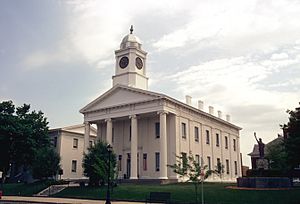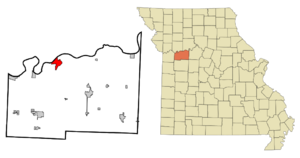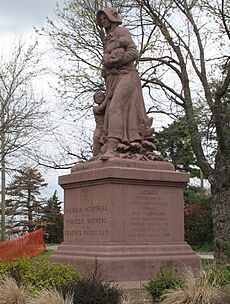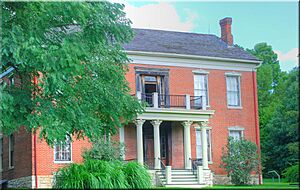Lexington, Missouri facts for kids
Quick facts for kids
Lexington, Missouri
|
|
|---|---|

The Lafayette County Courthouse in Lexington, MO
|
|

Location of Lexington, Missouri
|
|
| Country | United States |
| State | Missouri |
| County | Lafayette |
| Area | |
| • Total | 5.46 sq mi (14.13 km2) |
| • Land | 5.23 sq mi (13.54 km2) |
| • Water | 0.23 sq mi (0.59 km2) |
| Elevation | 810 ft (250 m) |
| Population
(2020)
|
|
| • Total | 4,652 |
| • Density | 889.82/sq mi (343.54/km2) |
| Time zone | UTC-6 (Central (CST)) |
| • Summer (DST) | UTC-5 (CDT) |
| ZIP code |
64067
|
| Area code(s) | 660 |
| FIPS code | 29-41870 |
| GNIS feature ID | 2395697 |
Lexington is a city in Lafayette County, Missouri, United States. It is the main city, or county seat, of Lafayette County. In 2020, about 4,652 people lived there.
Lexington is in western Missouri. It is about 40 miles (64 km) east of Kansas City. The city is famous for the Battle of Lexington State Historic Site. It was also home to the Wentworth Military Academy and College for many years.
Contents
Exploring Lexington's Location
Lexington is located on the south bank of the Missouri River. You can find it where Missouri Route 13 and US Route 24 meet.
The city covers a total area of about 5.38 square miles (13.93 square kilometers). Most of this area is land, with a small part being water.
People Living in Lexington
| Historical population | |||
|---|---|---|---|
| Census | Pop. | %± | |
| 1850 | 2,698 | — | |
| 1860 | 4,122 | 52.8% | |
| 1870 | 4,373 | 6.1% | |
| 1880 | 3,996 | −8.6% | |
| 1890 | 4,537 | 13.5% | |
| 1900 | 4,190 | −7.6% | |
| 1910 | 5,242 | 25.1% | |
| 1920 | 4,695 | −10.4% | |
| 1930 | 4,595 | −2.1% | |
| 1940 | 5,341 | 16.2% | |
| 1950 | 5,074 | −5.0% | |
| 1960 | 4,845 | −4.5% | |
| 1970 | 5,388 | 11.2% | |
| 1980 | 5,063 | −6.0% | |
| 1990 | 4,860 | −4.0% | |
| 2000 | 4,453 | −8.4% | |
| 2010 | 4,726 | 6.1% | |
| 2020 | 4,652 | −1.6% | |
| U.S. Decennial Census | |||
Population Details from 2010
In 2010, there were 4,726 people living in Lexington. These people lived in 1,867 homes. About 1,201 of these were family homes.
Most of the people in Lexington were White (87.3%). Other groups included African American (6.1%), Asian (0.9%), and Native American (0.5%). About 3.7% of the population was Hispanic or Latino.
The average age of people in the city was about 39.6 years old. About 23.8% of residents were under 18. Also, 17% of residents were 65 years old or older.
Lexington's Rich History
How Lexington Was Founded
Lexington was built on the high ground near the Missouri River. It was planned out in 1822. This was close to a ferry crossing that had started three years earlier. The town was named after the Battles of Lexington and Concord from the American Revolution.
In 1823, Lexington became the county seat for Lafayette County. This helped the town grow very quickly.
Growing as a Trading Hub
In 1822, John Aull opened a store in Lexington. His brothers soon joined him. Their company, Aull Brothers, became a large trading business. They had stores in other towns like Independence and Westport.
Many other merchants and farmers came to Lexington. They grew crops like hemp and tobacco. They also raised cattle. Because of its focus on trade and farming, Lexington had a significant population of enslaved people. Some old homes in town still have buildings that were once slave quarters.
Lexington became a very busy and successful city. In the 1830s and 1840s, it was the largest city west of St. Louis. It was a major stop for traders and pioneers. People would get supplies here before traveling west on famous routes like the Santa Fe Trail and the Oregon Trail.
Big companies, like Russell, Majors and Waddell, set up their main offices in Lexington. These men were very important in western trade. In 1860, they even started the Pony Express.
The steamboat business on the river was also very profitable. The city's dock was always busy. Coal mines nearby provided fuel for the steamboats. In 1852, a steamboat called the Saluda exploded near Lexington. Over 150 people died, and many children lost their parents. Some Lexington families adopted these orphaned children.
Amazing Architecture
Lexington has many beautiful old buildings. The Lafayette County Courthouse was built in 1847. It is the oldest courthouse west of the Mississippi River that is still used today.
The Masonic College, also built in 1847, later became a college for women. Christ Episcopal Church, built in 1848, has a beautiful wooden interior. Lexington has over 150 buildings from before the Civil War. Many people visit each year to see these historic homes.
Many of Lexington's historic buildings are listed on the National Register of Historic Places. This includes the Anderson House and Lexington Battlefield and the Wentworth Military Academy.
The Civil War and Its Aftermath
Lexington was the site of two major battles during the American Civil War. The most famous is the First Battle of Lexington, also known as the Battle of the Hemp Bales. On September 12, 1861, thousands of soldiers attacked the Federal army post.
The attacking soldiers used large bales of hemp as moving shields. They pushed these bales closer to the Federal headquarters. On September 20, 1861, the Federal troops surrendered. A cannonball from this battle is still stuck in a column of the Courthouse. It has become a symbol for the town.
Another battle, the Second Battle of Lexington, happened on October 19, 1864.
After the Civil War, Lexington did not regain its earlier importance. Kansas City became the main city in western Missouri. The arrival of the transcontinental railroad also meant less river trade for Lexington.
Despite this, Lexington became known for its schools. It was even called the "Athens of the West." Several colleges for women were founded here. The Wentworth Military Academy, started in 1880, was a very famous school. It attracted students from all over the world until it closed in 2017.
Businesses in Lexington
For many years, Lexington was the main office for Mattingly's and Matco Stores. These were large retail companies. Later, the company was sold to ShopKo and then Pamida. The Mattingly store legacy in Lexington ended in 2004.
Dunbrooke, a clothing company, started in Lexington in 1939. They first made dress shirts. Later, they became known for making jackets, especially for the Korean War. Today, Dunbrooke is a well-known maker of custom apparel.
Education in Lexington
The Lexington R-V School District runs Lexington High School. It also operates Lex La-Ray Technical Center. This center is a vocational school that teaches job skills.
Lexington also has a public library. It is part of the Trails Regional Library system.
Famous People from Lexington
Business Leaders
- William Hepburn Russell: A partner in Russell, Majors and Waddell, who founded the Pony Express.
- William C. Schwartz: A physicist and pioneer in laser technology.
- William B. Waddell: Another partner in Russell, Majors and Waddell and a founder of the Pony Express.
- James "Bud" Walton: Co-founder of the famous retail company Wal-Mart.
Sports Stars
- Chris Banks: An NFL football player who won the Super Bowl with the Denver Broncos in 1998.
- Lenvil Elliott: An NFL football player.
- Med Park: An NBA basketball player.
- Ron Tabb: A professional long-distance runner.
Military Heroes
- Alexander William Doniphan: A lawyer and hero from the Mexican–American War.
- William M. Hoge: He helped build the ALCAN Highway and captured the Remagen Bridge in World War II.
- Harold G. Schrier: He helped raise the flag over Iwo Jima during World War II.
Artists and Entertainers
- James Lane Allen: A well-known author.
- Maude Fulton: A Broadway actress.
- Randall Garrett: A science fiction and fantasy author.
- George Kriehn: A writer and lecturer about art.
- Carl Stalling: A famous composer for Bugs Bunny and other Looney Tunes cartoons.
Academics and Educators
- John H. Little: A superintendent of Wentworth Military Academy.
- James M. Sellers: A commandant, superintendent, and president of Wentworth Military Academy for many years.
- James M. Sellers Jr.: Also a superintendent of Wentworth Military Academy.
- Ovid R. Sellers: A scholar and archaeologist who studied the Old Testament.
- Sandford Sellers: The first president of Wentworth Military Academy.
- William W. Sellers: Another president of Wentworth Military Academy.
- Stephen G. Wentworth: A banker who founded Wentworth Military Academy.
- Lester B. Wikoff: An athletic director and superintendent at Wentworth Military Academy.
Religious Figures
- Judith Craig: A bishop in the United Methodist Church.
- Thomas Francis Lillis: A former Roman Catholic bishop.
See also
 In Spanish: Lexington (Misuri) para niños
In Spanish: Lexington (Misuri) para niños





